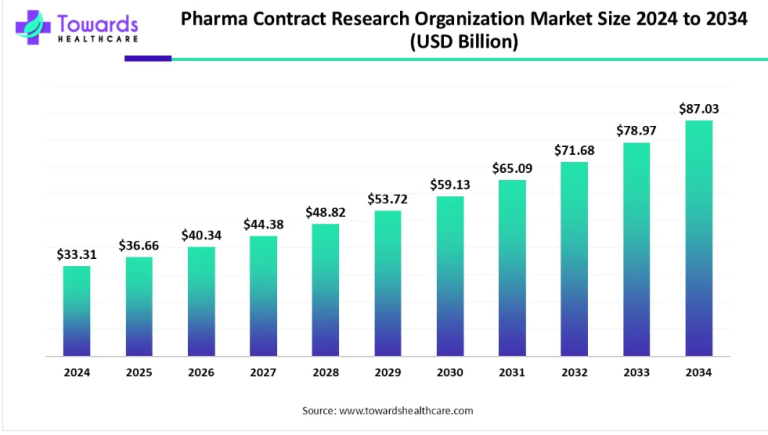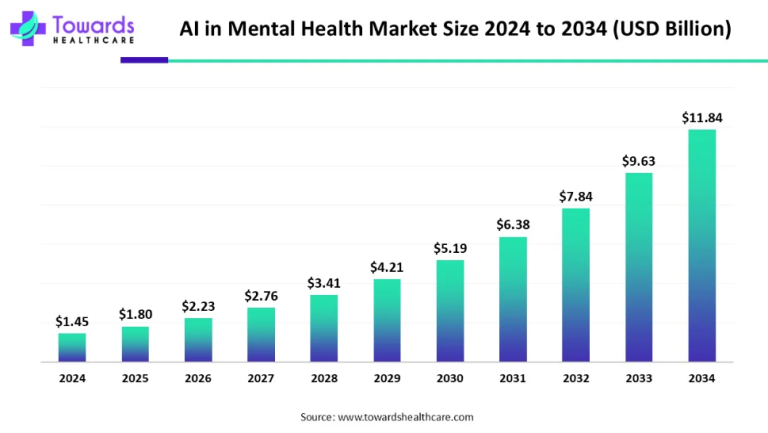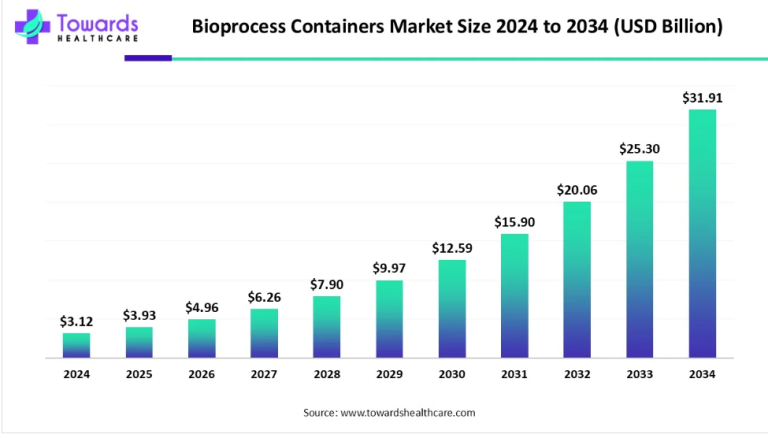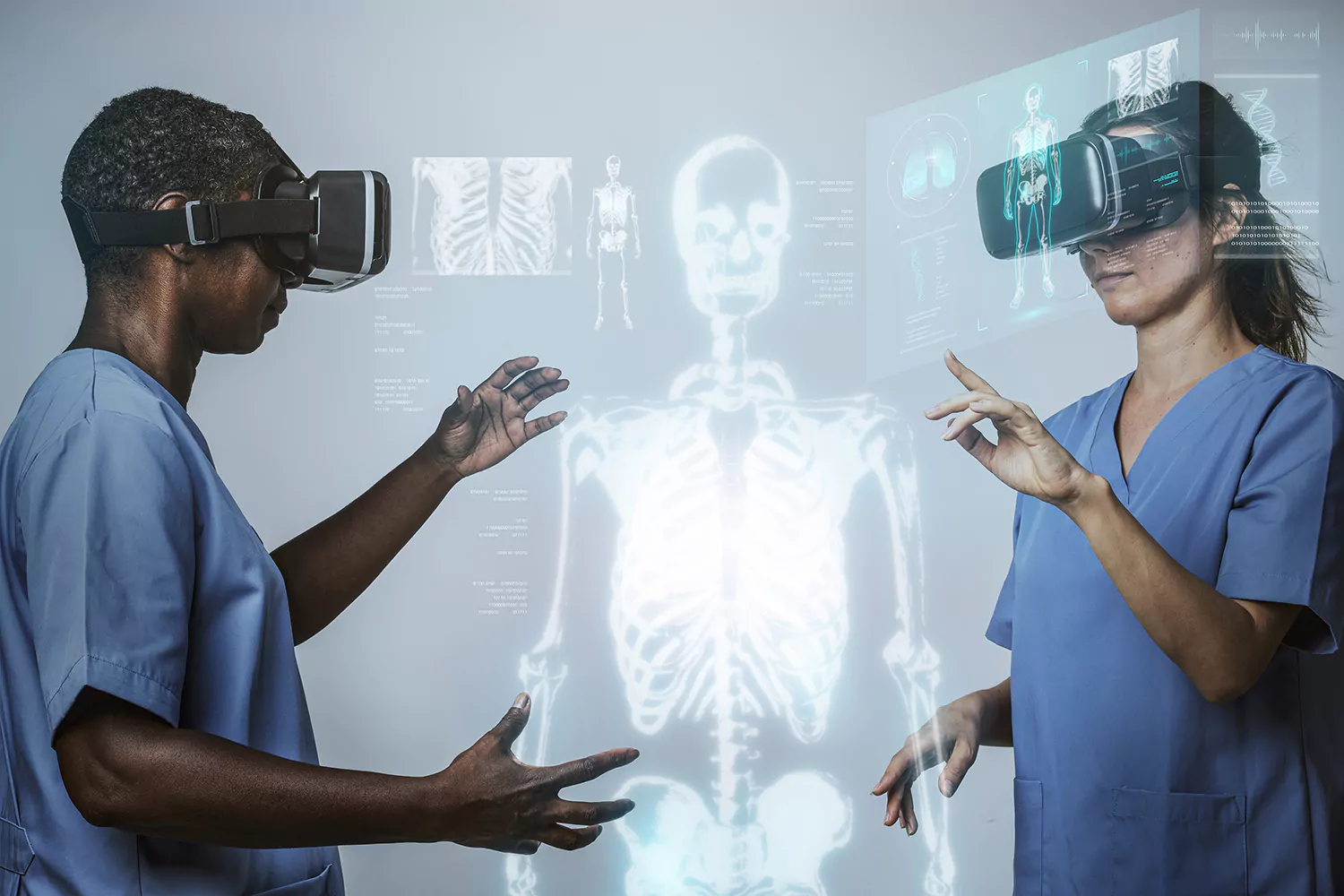
The global metaverse in healthcare market is poised for an extraordinary surge, projected to elevate from USD 8.29 billion in 2022 to an impressive USD 81.99 billion by 2032. This monumental growth is anticipated at a remarkable CAGR of 26.3% between 2023 and 2032, driven by the escalating development of healthcare infrastructure and the relentless pace of technology advancements.
Report Highlights:
- Metaverse in healthcare market is valued at USD 8.29 billion in 2022.
- Telemedicine’s integration into the metaverse catalyses a revolutionary transformation in healthcare markets.
- The impediment of high technology cost in healthcare metaverse growth.
- Broadening connectivity for collaboration with various fields creates an opportunity in the metaverse in healthcare market.
- North America’s dominance in the market is attributed to the greatest healthcare expenditure and developed healthcare infrastructure.
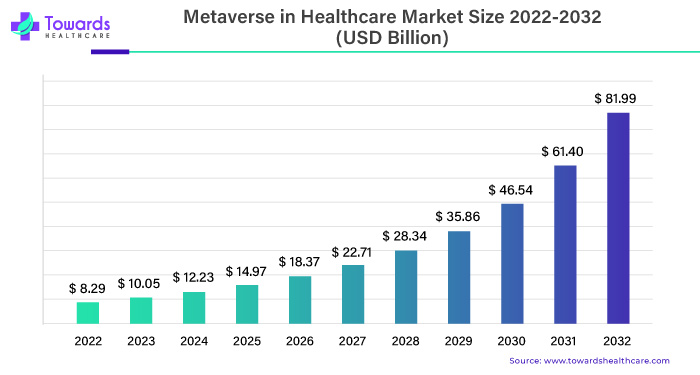
Impact on Metaverse in Healthcare Market Infrastructure:
- Revolutionizing Patient Care:
- Analyzing how the metaverse transforms patient care, providing personalized and immersive healthcare experiences.
- Enhanced Medical Training:
- Exploring the role of the metaverse in medical training, offering realistic simulations and experiential learning.
- Telemedicine Redefined:
- Redefining telemedicine through metaverse technologies, breaking barriers in remote healthcare delivery.
According to a recent metaverse poll, 66% of US corporate executives actively engage with the metaverse, and 82% expect it to be an aspect of “business as usual” within the next three years or shorter.
The metaverse in healthcare market is a platform for integrating the virtual and physical worlds. It allows people to interact with their models in a virtual reality, augmented reality, mixed reality, blockchain, digital twins, and artificial intelligence (AI) environment that is enhanced by virtually limitless data. The metaverse, which was first introduced as a social media entertainment platform, has the potential to significantly influence clinical practice and public health in the healthcare industry.
As a team of researchers from academia, business, medicine, and regulation, we recognize particular chances for metaverse methods in healthcare. A metaverse of “medical technology and AI” (MeTAI) can help develop, prototype, assess, regulate, translate, and improve AI-based medical practice, notably Medical Imaging-guided diagnosis and therapy.
The ongoing development of metaverse-compatible technologies has also demonstrated the potential to completely transform this approach to clinical skills training. Students may have rare opportunities to practice history and physical skills, complex clinical cases, and significant ethical issues in a low-stakes, safe environment through the simulation of virtual environments. The effectiveness of virtual reality (VR) in teaching clinical skills competency to nurses has also been extensively studied.
These studies suggest a remarkable potential for supplementing medical education, which warrants further investigation to develop a more thorough understanding of its implications.
For Instance,
- In 2021, Microsoft HoloLens 2x Healthcare was launched to enhance patient treatment by reducing time-to-care. Having HoloLens 2, health practitioners can interact with distant specialists, access patient data, and expand further X-rays to study MRI scans in 3D at the point of care. NHS reduced ward rounds by 30% with the help of HoloLens 2x.
- As per the CNBC news, Apple is gearing up to enter the virtual reality market, targeting the higher end users with 3,500 Vision Pro, which is expected to debut early next year. Meta Quest 3 is set to be released as soon as.
Applications of virtual reality education may be explored as early as the 1st year of medical school when preclinical education covers basic subjects like anatomy, radiology, and more. Universities have been known to use AR and VR in healthcare technology as extra teaching aids for medical anatomy, with encouraging results. Additionally, more research has been done on applying these tools in radiology education.
Uses of Metaverse in Healthcare Market
| Sr. No | Stream | Application | Examples |
| 1. | Radiology | A rise in the number of images viewed and altered watch more detailed moving images to help with illness or injury diagnosis | Image Restoration |
| 2. | Medicine/Psychiatry | Blockchain-based patient data security for telemedicine consultations | The FDA approved endeavorRX, a virtual reality game developed by Akili Interactive, as the first prescription-strength video game to treat attention-deficit/hyperactivity disorder (ADHD) in children |
| 3. | Surgery/Facial Surgery | Surgeons will have real-time access to the patient’s vital signs, pictures, medical records, and any additional data | Arbrea labs working on face simulation tools |
| 4. | Medical Wearable | Respiration Monitoring | In COVID-19, Chronic Pulmonary Obstructive Disorder |
The metaverse in healthcare market expansion reflects a growing recognition of its potential to revolutionize the industry, fostering collaboration and advancing medical practice on a global scale. As this trend continues, the metaverse in healthcare market is poised to play a pivotal role in shaping the future Healthcare delivery and innovation landscape.
Telemedicine’s Integration into the Metaverse is Catalyzing a Revolutionary Transformation in Healthcare Markets
A metaverse in healthcare market delivery model known as telemedicine uses telecommunications technology to provide medical services and consultations from a distance. Healthcare providers can diagnose and treat patients in real-time through video conferencing, mobile applications, and remote monitoring devices. This eliminates the need for in-person visits and allows patients to receive treatment from the comfort of their own homes. Because of its adaptability, telemedicine can be used for various medical services, such as mental health, primary care, and specialist consultations.
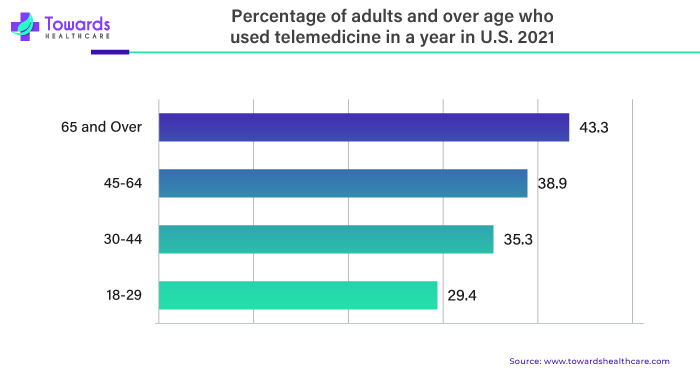
Metaverse in Healthcare Market Regional Dynamics:
- Global Impact:
- Assessing the worldwide influence of the metaverse in healthcare market, breaking down geographical boundaries.
- Contributions from Emerging Markets:
- Highlighting the contributions of emerging markets to the global metaverse in healthcare market.
The growing application of digital twins in healthcare has aided in the widespread adoption of telemedicine. A distribution digital twin implementation of a hemodialysis unit was proposed by Possik et al. to stop the spread of the COVID-19 variant Omicron and other infectious diseases. The system combined an agent-based discrete event simulator with a virtual reality environment. It also included a platform that displayed predictive analytics during the simulation run.
For Instance,
- In May 2023, Chung-Ang University Gwangmyong Hospital in South Korea developed a virtual hospital called “Metaversepital” using Digital Twin and Metaverse technologies. This allows patients to receive medical care and consultations without going to the hospital in person.
- In 2023, according to KPMG Survey conducted by HIMSS Analytics, In healthcare organizations, the use of remote patient monitoring and video-based telemedicine services is 31% and 34%, respectively. One such provider is American Well, which offers phone and video telehealth visits (mostly video-based) and has begun on-demand virtual care services in collaboration with Thomas Jefferson University Hospitals.
One method that has shown promise for changing the way urological consultations are provided is telemedicine. It has produced satisfactory results for patients and clinicians while drastically cutting costs and time.
For Instance,
- In 2022, the National Health Institute published an article, “Telemedicine and Telehealth in Urology”, which found that for urological cancer care and counselling, telemedicine was just as successful as in-person visits. Specifically, telemedicine has made it possible to treat urological issues connected to sexual health in a comfortable and patient-centred way.
The convergence of telemedicine and the Metaverse represent a groundbreaking synergy, offering innovative solutions and immersive experiences for both healthcare providers and patients. This dynamic integration facilitates enhanced communication, diagnosis and treatment options, fostering a more accessible and inclusive healthcare ecosystem.
Exploring the Revolutionary Impact of Mixed Reality in Healthcare Training and Surgery within Metaverse
The metaverse in healthcare market is becoming increasingly crucial in urological surgery, including surgical training, thanks to recent technological advancements. The idea of image-guided intervention and surgery has been discussed in great detail, and the use of 3D-printed phantoms has confirmed the effectiveness of AR visualization for image-guided surgery. AR technology enables surgeons to obtain patient information without using their hands by superimposing a 3D virtual model onto a patient’s body. Additionally, real-time visualization of the tumour’s characteristics and 3D anatomy—unique to each patient—is made possible by combining augmented reality technology and the patient’s anatomy, enhancing the safety and effectiveness of surgical procedures.
Robotic procedures have firmly established themselves in the ever-evolving landscape of urological surgeries, particularly in ureteral reconstruction. The integration of advance technologies, such as fluorescence-guided surgery and 3D imaging, is rapidly transforming the field of urology. These innovations provide surgeons powerful tools, enhancing their comprehension of patient-specific anatomy. Pediatric urology has witnessed a surge in the adoption of Augmented Reality (AR) devices, offering a more lifelike grasp of normal and abnormal anatomies. This shift allows for real-time insights, enabling tailored treatments.
For Instance,
- A notable instance of technology integration can be seen at the Minimally Invasive Surgery Centre (CCMIJU) in Spain, where mixed reality experiences are made possible by Microsoft’s HoloLens glasses.
- In February 2022, the Apollo Hospital Group launched a partnership with 8chili Inc. Apollo Hospital facilitates involvement in the Metaverse, which encourages participation in the metaverse.
The global increasing interest in the metaverse in healthcare market amplifies this transformative wave. The growing emphasis on metaverse technologies signifies a broader trend towards advancing healthcare practices, fostering enhanced collaboration and training, and ultimately, improving patient care on a global scale.
The Impediment of High Technology Cost Metaverse in Healthcare Market Growth
The burgeoning potential of the metaverse in healthcare market needs to be improved by the substantial costs associated with high-end technologies.
In May 2022, The National Institute of Health’s article explores how financial barriers pose challenges to adopting and advancing metaverse solutions in the healthcare market. Addressing the financial barriers associated with high technology costs is crucial for unlocking the full potential of the metaverse in healthcare market.
| Financial Barriers to Entry | The intricate technologies required for an immersive healthcare metaverse experience demand substantial financial investments. From cutting-edge virtual reality (VR) systems to sophisticated augmented reality (AR) applications, the expenses can be prohibitive, limiting the number of healthcare institutions able to embrace these transformative tools. |
| Infrastructure Costs | The comprehensive setup adds to the overall expenditure, making it difficult for many healthcare providers, particularly smaller ones, to participate in the metaverse revolution. |
| Development and Maintenance Expenses | The dynamic nature of technology requires continual investment, deterring potential adopters who might find it challenging to keep up with the evolving requirements. |
| Limited Accessibility for Patients | While metaverse in healthcare market solutions have the potential to revolutionize patient care, the high costs limit accessibility for individuals. |
| Research and Development Costs | The innovation required to enhance healthcare metaverse capabilities demands significant research and development investments. Companies working on pushing the boundaries of metaverse technology face financial challenges, slowing down progress and delaying the realization of its full potential in healthcare. |
Broadening Connectivity for Collaboration with Various Fields Creates an Opportunity in Metaverse In Healthcare Market
With the COVID-19 pandemic, people are becoming more interested in virtual reality to get around restrictions on social activities. In addition, as digital financial technologies like blockchain and virtual currency continue to advance, the range of roles that can be filled in the metaverse in healthcare market is expanding since X.R. technologies are primarily used to implement the metaverse platform.
The technology known as metaverse can carry out tasks not limited by the physical world and simultaneously facilitate activities like social networking and education. The metaverse interface, for instance, can provide business platforms, real estate, and private offices. Expanding the metaverse requires providing users with sustainable services, and user-friendly interfaces, connectivity, and high usability are essential for sustainability. To meet these demands, sophisticated wearable technology, quick communication, and integration across multiple fields are needed.
For Instance,
In the first five months of 2022, corporations, venture capitalists, and private equity firms invested over $120 billion in the metaverse. The proto-metaverse is dominated by immersive use cases involving augmented reality (A.R.), virtual reality (V.R.), and mixed reality (M.R.).
- In 2022, Latus Healthcare has created a “Virtual Hospital.” The first treatments will focus on physiotherapy services in a virtual reality hospital setting.
- In 2022, iMining developed The Decentral and Metaverse’s first hospital foundation ever to be established.
- In January 2022, ImmersiveTouch implemented new digital surgery technology at All India Institutes of Medical Sciences (AIIMS), New Delhi.
Analysts are optimistic about the continuing growth in the post-COVID era due to the growing need for digital care. Leading players in the value chain, such as tech firms, insurance companies, healthcare providers, and producers of pharmaceuticals and equipment, have begun spearheading efforts to promote the adoption of the metaverse.
The Application of the Metaverse in Healthcare Market is Indeed Contributing to Significant Increase in the Market’s Global Expansion
Researchers can create and access virtual laboratories that simulate real-world scientific environments in the metaverse. These labs can replicate various aspects of the drug discovery process, from molecular modelling to in-silico testing. Virtual labs allow for accelerated drug discovery by leveraging computational simulations and artificial intelligence. Researchers can conduct experiments in a digital space, significantly reducing the time and resources required compared to traditional laboratory experiments. The metaverse provides a platform for seamless global collaboration among researchers.
Scientists worldwide can connect in the virtual space, share insights, and work together in real-time, overcoming geographical and time zone constraints. Virtual labs facilitate the easy sharing and integration of data. Researchers can collaborate on datasets, experimental results, and models in real time, fostering a more open and collaborative research environment.
Virtual labs can contribute to cost efficiency by reducing physical resources and laboratory equipment need. This can make drug discovery more accessible to a wider range of researchers and institutions. Researchers from different disciplines, such as biology, chemistry, and computer science, can collaborate seamlessly in the metaverse. This interdisciplinary approach can lead to innovative solutions and perspectives in drug discovery.
Virtual labs offer real-time collaboration features, including instant communication, co-authoring of documents, and joint data analysis. This enhances the efficiency of collaboration and accelerates the decision-making process. The integration of virtual labs in the metaverse in healthcare market for drug discovery and development can revolutionize the field, making the process faster, more collaborative, and cost-effective. It represents a paradigm shift towards a more digitized and interconnected approach to scientific research.
The increased integration of metaverse technologies in these healthcare sectors will likely drive innovation, improve accessibility, and expand the global market for healthcare-related metaverse solutions.
Geographical Landscape
North America has maintained its top position and is expected to do so for the projected period. Because of the quick development of the healthcare infrastructure and the widespread use of digital technology, The reason for this is the region’s high concentration of businesses centred around the metaverse, the healthcare industry’s quick infrastructure development, the merging of A.R. and V.R. platforms.
The rise in investments in A.R. products and services, and developments in Hardware and Software, Many mental health issues, such as phobias, anxiety disorders, delusions, and hallucinations, can be treated with the metaverse in healthcare market. We can now seek help from friends, family, coworkers, or medical professionals when we are having a mental breakdown because of technology. As a result, future growth in this area is projected.
Metaverse in Healthcare Market Development in U.S.
- In February 2022, Epazz DeskFlex launched Metaverse Virtual Clinics, the next-generation telemedicine for physicians and healthcare facilities.
- In April 2022, Epazz reported a 28% rise in revenue and an 1168% in EBITDA.
During the forecast period, Asia-Pacific is expected to grow the fastest in the metaverse in the healthcare market. China, Japan, India, and other countries are included in this region. This region is growing due to the country’s technological advances in the metaverse in healthcare market. Collaborations between metaverse technology companies and the healthcare industry fuel growth and significant investment in integrating this technology with medical equipment.
Competitive Landscape
The competitive dynamics within the metaverse in healthcare market, examining key market vendors. This involves a comprehensive analysis encompassing revenue metrics, expenditure patterns, resource allocation, product portfolios, regional coverage, market share, noteworthy initiatives, product launches, and pertinent news updates related to this burgeoning sector.
It’s imperative to note that the competitive landscape and metaverse in healthcare market growth are significantly influenced by innovation and recent developments. Collaborations and partnerships are pivotal in shaping this landscape, fostering an environment ripe for advancements and augmenting the overall market trajectory.
Recent Developments
- In December 2021, Aimedis published Health Metaverse and opened the 1st clinic in Health City, Limburg, Netherlands.
- In February 2022, Aimedis created Avtar for Aimedis Health City.
- In April 2022, 8chilli demonstrated a Cardiology Solution in Metaverse at the American College of Cardiology, San Francisco, USA.
- In January 2022, Epazz introduced an affordable metaverse solution for businesses, governments, and healthcare providers.
- In February 2022, XRHealth secured $10M to expand virtual healthcare treatment in the metaverse.
Metaverse in Healthcare Market Players
- PlushCare
- Intuitive Surgical Inc.
- Siemens Healthineers
- BioFlight VR
- Novarad Corporation
- Microsoft Corporation
- GE Healthcare
- Veyond Metaverse
- gameChange VR
- Medtronic PLC
Metaverse in Healthcare Market Segments
By Component
- Software
- Hardware
By Technology
- Augmented Reality
- Virtual Reality
- Artificial Intelligence
- Mixed Reality
- Blockchain
- Others
By Devices
- VR Headsets
- AR Devices
- Mixed Reality Platforms
By Application
- Telemedicine and Remote Care
- Medical Training and Education
- Mental Health and Rehabilitation
- Drug Discovery and Development
- Medical Diagnostics
By End User
- Medical Training & Education
- Modules
- Diagnosis
- Treatment
- Others
By Geography
- North America
- Europe
- Asia-Pacific
- Latin America
- The Middle East and Africa
